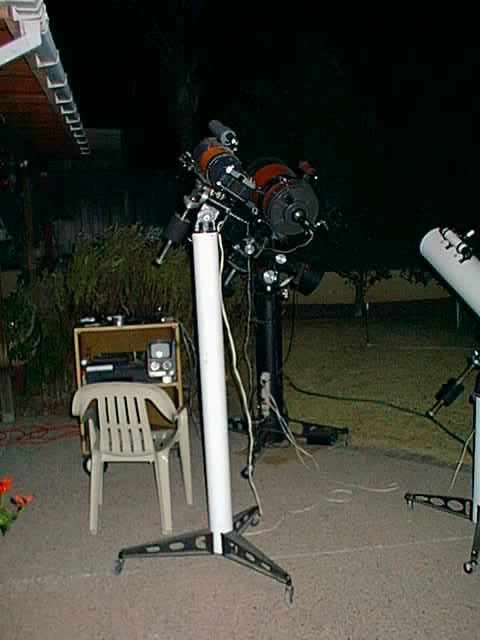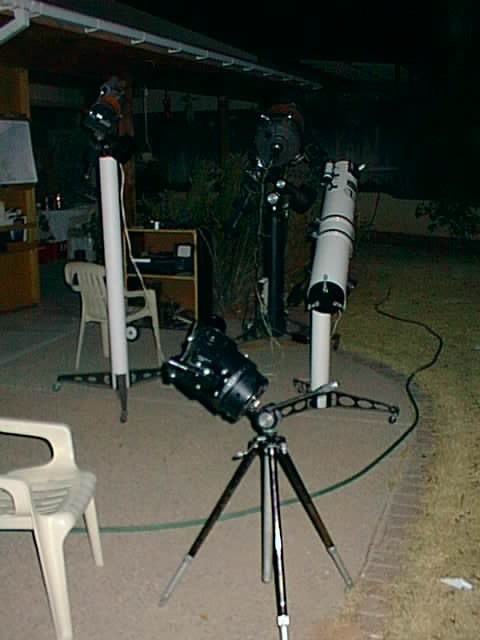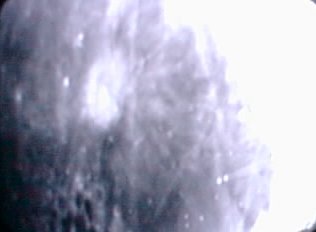Jim Loudon Observatory
Lunar Eclipse Observations
2000
-01-21
 The images above were taken with a Celestron 5 and Fuji 1600
film.For a full sized image click on the image above.
The images above were taken with a Celestron 5 and Fuji 1600
film.For a full sized image click on the image above.
More Moon images on this page!
Richard E. & Dolores H. Hill
JIM LOUDON OBSERVATORY
10130 E. King Manor
Tucson, AZ 85730
Longitude:110.77554 deg. W or 110 deg. 46' 31.9"
Latitude: 32.18006 deg. N or 32 deg. 10' 48.2"
Height above sealevel: 2875 ft.
Equipment:
C11 data recorded with GBC505e video camera.
piggy back was a Sharp videocam for wide field record.
6" f/8.3 RV-6 Newtonian for crater timings.
C5 for direct film imaging.
ETX for visual and showing guests.
Full report
on activities.
=====================================

In the foreground is the C5 with camera body attached. In the background
is the C11 fitted with two video cameras and to the right the RV-6.

From this angle the ETX can be seen in the foreground. This telescope
was used to show the eclipse to visitors. Notice how it is separated
by some feet, from the other telescopes!

Here we can see the arrangement for the C11. A Sharp videocam was
piggybacked off to one side while the GBC505e was videotapeing through
the C11 itself. To the left can be seen the video card with VCR,
monitor, and mixer for dual audio input.

This view shows the video equipment well.

And this view shows the tangle of cables well!

A close-up of the video equipment.

Oh yes, the neighbors came for a view.

Towards the end of the eclipse the Moon was nearly on the meridian.
(Note the practised and skillful use of duct tape!)

Notice the Moon on the monitor to give and idea of the scale used.

A view of Mare Fecunditatis, with Langrenus left and the Messier twins
right, from the monitor using a broadband H-alph filtration on the video
camera.
==================================================================
observational report
==================================================================
As the moon rose it was obscured by stratus clouds giving us plenty of
time to set up. We began observations shortly after 0200 (all times
here will be UT). The penumbra was first visible by eye around 02:20.
The first photos were taken before first contact. By 02:30 the moon was
decidedly darker to the east. A particularly large mountain was noticed
on the lunar limb close to Tycho. It was the largest protuberance
visible on the limb. The sky was covered almost completely with hazy
cirrus making crater timings and photometry impossible. But photography
and video observations proceeded. The C11 was being used to look for
impacts on the moon during totality while the Sharp camera was just
recording the wider field scene to make a record of the eclipse.
Video observations with the C11 began around the Aristarchus region
using a wide band H-alpha filtration to try and reduce the blue
scattered light from the haze. This began around 03:20. By this time
the moon was getting a very 3-D look to it as the shadow crawled across
it. Several bright 'flashes' were seen but as yet not scrutinized to
where they can be reported.
At mid-eclipse using reversed binoculars the Moon's light was compared
to stars. It was seen as equal to or slightly fainter than Betelgeuse.
It was slightly red but not strongly. A Danjon estimate of 1.5 was
made. The sky was clearing making wide field photography possible.
Photographs of the totally eclipsed moon and M44 were taken. Totally
ended at 05:22, exactly on the predicted time.
Because of the clearer sky, crater timings were begun at 05:36 and
continued to the third contact (see below). Hazy clouds began forming
to the west and moved into the whole sky by the end of totality and the
humidity began to rise. Totality ended on the predicted time of 06:25.
Wide field video continued for another half hour.
==================================================================
CRATER TIMINGS - all done with 6" f/8.3 RV-6 Newtonian
CRATER UT
-------------------------------------
Aristarchus 05:36:45
Kepler 05:36:55
Tycho 05:39:55
Copernicus 05:45:25
Birt 05:45:15
Pytheas 05:46:40
Timocharis 05:51:10
Plato 05:54:50
Manilius 06:00:20
Dionysius 06:03:25
Menelaus 06:03:35
Plinius 06:07:40
Censorinus 06:10:15
Goclenius 06:13:40
Proclus 06:17:15
Taruntius 06:17:35
Langrenus 06:18:50
The images above were taken with a Celestron 5 and Fuji 1600 film.For a full sized image click on the image above.









